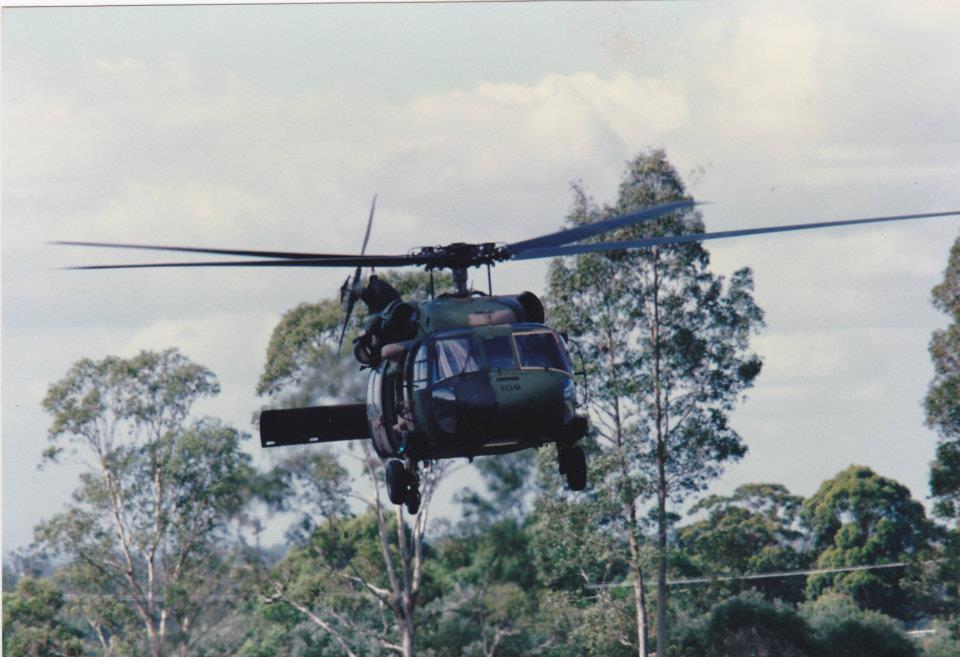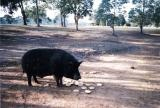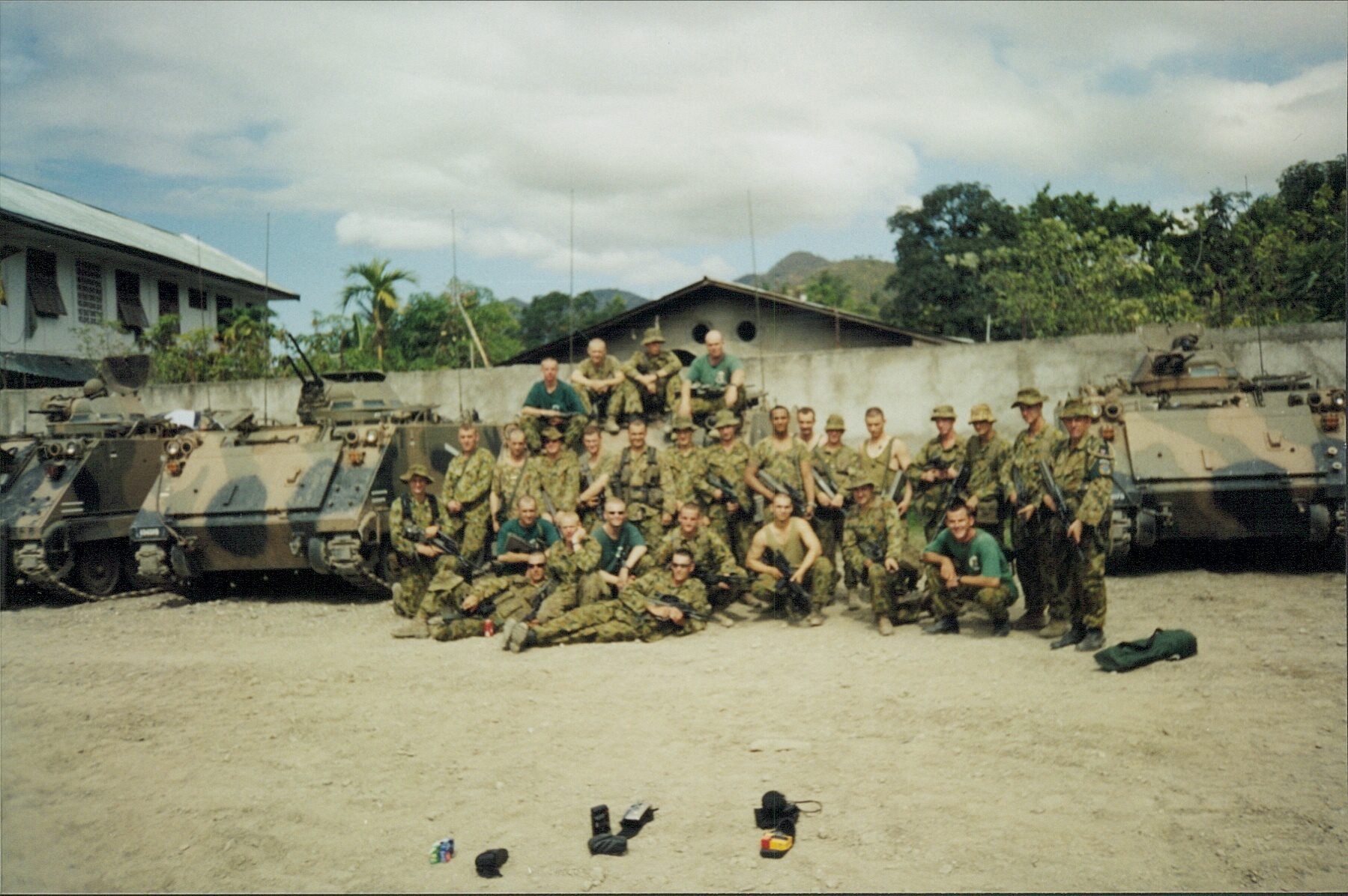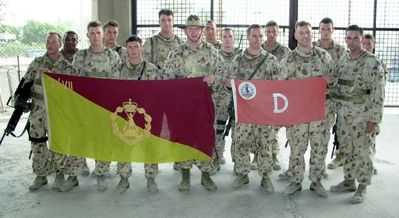Brief History
Brief History
5th/7th Battalion (Mechanized), The Royal Australian Regiment
3 Dec 73
Linking of the Battalions
At Tobruk Lines, Holsworthy on 3 Dec 73, 5 RAR and 7 RAR linked to form the new battalion, 5/7 RAR. Soldiers, non-commissioned officers and officers were drawn from both battalions to form the new battalion. The 5 RAR mascot, then SGT Quintus, and the 7 RAR Pipes and Drums were adopted by 5/7 RAR.
1974
Rifle Company Butterworth
Throughout 1974, the battalion was involved in individual and collective company training. Charlie Company spent the period Mar – Jun 74 in Malaysia supporting the RAAF at Butterworth. The Rifle Company Butterworth commitment would continue to provide valuable training with a company being detached almost every year until the Battalion was delinked 33 years later in 2006.
13 Jan 75
Cyclone Tracey
On 13 Jan 75, the battalion received a warning order from 1 TF to form the major part of Field Force Group Darwin (FFGD). The task of FFGD was to assist the civilian population of Darwin in the clearing of houses damaged by Cyclone Tracy, which had struck Darwin on Christmas Day 1974. The Commanding Officer, LTCOL E.J. O’Donnell, MC was appointed Commander of FFGD. The reconnaissance group arrived in Darwin on 15 Jan 75 and the main body arrived from 18 Jan 75. On 8 Mar 75, CO 5/7 RAR handed over command of FFGD to CO 6 RAR, and the Battalion returned to Holsworthy. During 5/7 RAR’s tour, it cleared 3288 blocks of land, 26 schools, two warehouses, one recreational ground, four shops, one hospital and re-roofed 136 houses.
1976
Mechanization Trial
In 1976, 5/7 RAR began a mechanized infantry trial. The trial was sponsored by Field Force Command and directed by 1 TF. 5/7 RAR accepted its first armoured personnel carriers from 2 Cav Regt at a parade on 17 Sep 76. The trial continued for just under two years until Jul 78. The CO during the trial, LTCOL M.P. Blake, MC, concluded that “… a mechanized battalion has the capacity of three infantry battalions.”
Feb 78
Hilton Bombing
In an impressive demonstration of speed and flexibility, the battalion responded to a short notice call out to secure the route from Sydney to Bowral following a terrorist threat to the Commonwealth Heads of Government Meeting in Sydney in Feb 78.

1985
At the completion of the trial, the battalion returned the majority of its APCs. A company allocation and a limited number of headquarters and specialist vehicles remained, and these were rotated annually between companies to keep alive the skills learnt during the trial.
Exercises during the following years often included the use of carriers from the Divisional Pool at Puckapunyal. Major activities in this period included Exercise ‘DROUGHT MASTER’ in western NSW in 1980, umpiring and exercise control tasks during ‘KANGAROO 81’, a deployment of the battalion (minus) to Tasmania in early 1982 to assist with bush fire fighting and participation in the overload trial of HMAS Tobruk in 1982.
In 1983, it was decided to equip a second mechanized Company (Delta Company). The battalion was authorised to re-equip to its full peace time establishment of APCs in June 1984 and the battalion adopted the suffix “(Mechanized)” from that date. APCs continued to arrive to complete the new establishment until November 1984. The first battalion level mechanized exercise was ‘TASMAN WARRIOR’ conducted at Shoalwater Bay in late 1985.
1985
Training at Battle group level was conducted at least annually, and occasionally at brigade level. The routine of mechanised training at Puckapunyal and Cobar; and later at Shoalwater Bay, Woomera and the Northern Territory, was interspersed with periodic three month company deployments to Butterworth in Malaysia in support of the Five Power Defence Agreement. Typically these deployments involved exercises with the Royal Malay Regiment in Sabah, the use of urban training facilities in Singapore, live firing at Pulada and local jungle training near Sik. During the 1993 Butterworth tour of Bravo Company, five soldiers were killed in a vehicle accident at Pulada.
In addition to these tasks, the battalion was a frequent visitor to Canberra providing guards of honour for visiting Heads of State and military chiefs, a task in later years to be performed by the Australian Federation Guard. In 1988 the battalion made a significant commitment to the conduct of the Bicentennial Military Tattoo which for six months redirected the battalion’s efforts from training to drill and ceremony.

1986
Mascots
In 1986, Delta Company was presented with a bush piglet by staff from Land Command Battle School, Tully who was subsequently named ‘Willis’ and became the unit’s unofficial ‘live-in’ mascot recognising the ‘pig’ tradition of 7 RAR. Renowned for his massive bulk and appetite for apples, ‘Willy’ resided in a wallow not far from the back kitchen door of the ORs Mess. He wandered freely in the battalion area but always returned for meals. Willis died of old age not long before the battalion departed for Darwin, perhaps he knew the quarantine rules would prevent him from going North.
WO2 Quintus, the original mascot inherited from 5 RAR, having taken discharge on 2 Dec 85, died in 1988. His replacement, Quintus Secundus, a Bengal Tiger, was housed at Bullens’ Animal World. Enlisted on 3 Dec 85 and promoted to CPL on 9 Sep 88 he was retired on the move of the Battalion to Darwin. Quintus Septimus, a resident of Crocodylus Park in Darwin was enlisted as the Battalion’s new mascot in 2004.
1992


1999
INTERFET/UNTAET
The Battalion was put though several long and demanding exercises to test its deployment and operational capabilities. New military equipment and personnel arrived almost on a daily basis and within a compressed timeframe the Battalion was declared ‘ready’. With the possibility of a deployment to East Timor becoming more likely, the Battalion’s training became tightly focused and the Battalion Group was formed, with: 103rd Medium Battery providing a forty man Civil-Military Liaison Group; 2nd Field Troop (Mechanized) from 1st Combat Engineer Regiment providing mobility support; and a 2nd line logistic Company from 1st Combat Service Support Battalion in direct support making up the larger attachments. The three mechanized rifle companies were at full strength and Support Company restructured with Mortar and Reconnaissance Platoons to become Patrols Company.

The Battalion group was allocated from under command HQ 3rd Brigade to under command of DILICOMD from 11 Oct 99 (commanded by Brigadier Martin Dunne of the NZ Army) where it was the primary unit responsible for the security of an expanding AO CITADEL. These security tasks were essentially conducted by the sub-units within their designated TAOR (all named after previous COs of 5, 7 and 5/7 RAR – a method that stayed with the battalion throughout its tour). Companies performed these responsibilities through extensive and continual patrolling on foot, supported by the vehicles. On a typical day the Battalion Group was involved in approximately 40 patrols throughout the AO, in addition to the required key point security tasks. The Civil-Military liaison and intelligence functions in support of the security tasking were coordinated through Battalion Headquarters.
The Battalion Group continued operations in AO CITADEL until late December when it conducted simultaneous reliefs in place to hand-over its central responsibilities to Kenyan and Italian units, whilst taking over 2RAR’s responsibilities on the border with West Timor. This task was complicated by a short notice surge activity in Dili on New Years Eve, when the Battalion was ordered back on the streets to counter a predicted attack on key East Timorese leadership. Delta Company and Patrols Company were hastily returned to patrolling and key point security tasks within the capital, further highlighting the flexibility of the Battalion to rapidly change its point of main effort when required.
Oct - Nov 2001
Operation RELEX

13 Oct 02
UNTAET

Mar 2004
RAMSI


May 2004
SECDET
Whilst the Battalion provided forces for ongoing operations it remediated the Battle Group mechanized capability with a test exercise on EX Predator’s Gallop 04 and became the online Deployable Battle Group.
Feb 2005
AMTG I
The first AMTG (AMTG 1) deployed in April 2005 and was based upon 2 Cav Regt with Bravo Company, 5/7 RAR providing the infantry company, known as Combat Team Tiger. A number of other personnel from the Battalion deployed with AMTG 1 to round out the HQ and logistics. Combat Team Tiger worked from a combination of ASLAV armoured recon vehicles and Bushmaster infantry mobility vehicles. Operating from CAMP SMITTY (named after a British soldier KIA) CT Tiger provided security to Japanese and other reconstruction activities, conducted counter threat security patrols and secured the AATTI during their mission.
Nov 2005
AMTG II
AMTG 1 handed over to the 5/7 RAR led AMTG 2 in early Nov 2005. AMTG 2 consisted of the Battalion’s Headquarters, Charlie Company (Combat Team Quintus), Logistics Company (including Technical Support Company which had amalgamated with Admin Coy earlier that year), elements of Support Company, a squadron from 2 Cav Regt (Combat Team Courage) and contributions from other units across Australia but largely 1 Brigade. AMTG 2’s operations were similar in nature to AMTG 1. AMTG 2 handed over to AMTG 3 (2 RAR lead) in late Jun 2006.
The Al Muthanna province was part of the British area of operations and had previously been secured by the Dutch. Al Muthanna was a very large but relatively poor rural province, mainly populated by the Shiite community. The regional capital, As Samawah, was a city of approximately 250,000 people. The Province was one of the more stable locations in Iraq but the security situation remained unpredictable as local militia considered the British and Australian forces as obstacles to achieving political and economic influence. During the 5/7 RAR led tour, the British and Australian forces recorded 42 contacts yet managed to achieve their operational tasking whilst maintaining the Province’s character as ‘relatively peaceful’.
May 2006
OOBG II
Back in Darwin, Delta Company continued to maintain the mechanized capability for the Battalion, learning and re-learning hard won experience in the conventional operations that had of necessity been undermined by constant security operation deployments. With the short notice deployment to Timor in May 2006 of the 3 RAR led RAR Battalion Group (with companies from 1 RAR and 2 RAR), Delta and Bravo companies commenced working up to ensure that there was a reserve capability available to respond to any other immediate operations.
In November 2006, Delta Company deployed to southern Iraq as part of the 2 Cav Regt led Operational Overwatch Battle Group (West) Two (OBG(W)). The OBG(W) was a flow on from AMTG and operated out of the US led Tallil Air Base in Dhi Qar Province. The Battle Group was responsible for providing security in depth by maintaining a presence within Al Muthanna and Dhi Qar Provinces as the Iraqi security forces took the lead for providing their own security. The Battle Group continued to train and mentor Iraqi forces through the AATTI.
Delta Company’s deployment to southern Iraq marked the last operational deployment for the 5th/7th Battalion prior to de-linking. Since East Timor in late 1999, the Battalion was continually operationally deployed or preparing for deployment up until the time of de-linking. With its organic mobility and inherent flexibility to be able to adopt other mobility platforms or deploy dismounted, the Battalion became a ‘highly preferred’ option for operational deployments.
Aug 2006
Bravo Company deployed to Uruzgan province in southern Afghanistan in August 2006 as part of OP SLIPPER, providing force protection for the 1 CER led Reconstruction Task Force (RTF 1). Operating from the Dutch led base at Tarin Kowt, Bravo Company patrolled on foot, in Bushmaster IMV and supported by LAV 25; to provide security for the engineers undertaking reconstruction tasks in support of the provincial government. They would return to Australia in April 2007.
Feb 05
Hardened and Networked Army
The Battalion had returned from AMTG 2 to see the “Hardening The Army” Plan reshaping the combined arms capability of the Brigade. The plan would see the Leopard MBT of 1 Armd Regt replaced with Abrams M1 MBTs, the introduction of the Tiger Armed Reconnaissance Helicopter into 1 Avn Regt, among many other developments. Most significantly, on 24 August 2006, the Prime Minister, Mr. Howard, announced that the Battalion would be de-linked, with 5 RAR and 7 RAR both to be established as mechanized battalions, initially in Darwin, until new facilities were established for 7 RAR in Adelaide. Charlie Company immediately began training IETs in the Battalion to provide for the necessary reinforcements.
03 Dec 06
Delinking
The de-linking occurred on the Brigade Parade Ground at Robertson Barracks, on 3 Dec 06, the anniversary of the founding of the Battalion. In Afghanistan, Bravo Company would pause whilst on operations to acknowledge the end of an era. After a simple ceremony in Darwin, the colours were marched off separately, bringing to an end 33 years of loyal and faithful service to the nation and the Regiment. The colours of the Battalion would later be laid up in the Soldier’s Chapel at Kapooka. Both events were witnessed by Colonel Paul Greenhalgh, AM, Retd, the founding CO of the Battalion.
In its relatively short history, thousands of men passed through the Battalion; some for short tours, for others their service would encompass almost the entire history of the Battalion. Whether their service was short or long, most would agree with the celebrated summation made by Jo Gullett [1] of his service in an infantry battalion:
‘An effective battalion, in being, ready to fight, implies a state of mind–I am not sure it is not a state of grace. It implies a giving and a taking and a sharing of almost everything–possessions, comfort, affection, trust, confidence and interest. It implies a certain restriction, and at the same time, a certain enriching and widening of the human spirit. It implies doing a hundred things together–marching to the band, marching all night long, being hungry, thirsty, exhausted, filthy; being near but never quite mutinous. It involves not the weakening but the deferment of other bonds and interests; the acceptance that life and home are now with the battalion. In the end it is possible to say ‘the battalion thinks’ or ‘the battalion feels’ and this is not an exaggeration.
In assisting other Australians to recover from disaster: cyclone, fires and floods; in conducting stabilization operations in Zimbabwe, East Timor and the Solomons, peacekeeping in Cambodia and Rwanda, and war fighting in Iraq and Afghanistan, the 5th/7th Battalion served the nation with distinction in war and in peace.
The men of the battalion inherited a proud tradition of soldiering and service from those of 5 RAR and 7 RAR at the linking in 1973. They sustained that tradition through the long and meagre years of peacetime soldiering in the 70s and 80s where Holsworthy, Puckapunyal and Sydney Field build another generation of soldiers and their leaders ready for the challenges of operations in the 90s and a new century. In 2006 they returned that tradition to where it belonged, not only sustained, but embellished; to be honored and sustained with pride in the new 5 RAR and 7 RAR.
Commanding Officers
| Period | Commanding Officer |
| 3 Dec 1973 – 12 Jan 1975 | LTCOL P.N. Greenhaigh |
| 13 Jan 1975 – 10 Jan 1977 | LTCOL E.J. O’Donnell, MC |
| 11 Jan 1977 – 7 Nov 1978 | LTCOL M.P. Blake, MC |
| 8 Nov 1978 – 11 Dec 1980 | LTCOL G.C. Skardon |
| 12 Dec 1980 – 9 Dec 1982 | LTCOL P.M. Arnison |
| 10 Dec 1982 – 13 Dec 1984 | LTCOL P.L. McGuinness |
| 14 Dec 1984 – 12 Jan 1987 | LTCOL J.A. Jones |
| 13 Jan 1987 – 15 Jan 1989 | LTCOL J.R. James |
| 16 Jan 1989 – 14 Dec 1990 | LTCOL R.J. Margetts |
| 15 Dec 1990 – Dec 1993 | LTCOL P.A. Pedersen |
| Jan 1993 – Dec 1994 | LTCOL G. Byles |
| Jan 1995 – 18 Dec 1996 | LTCOL C.G. Appleton |
| 19 Dec 1996 – 18 Jan 1999 | LTCOL W. T. Bowen, SC, AM |
| 19 Jan 1999 – 19 Dec 2000 | LTCOL S.C. Gould, DSC |
| 20 Dec 2000 – 15 Jan 2003 | LTCOL M.G. Tucker, MBE |
| 20 Jan 2003 – 15 Jan 2005 | LTCOL M.D. Lean |
| 16 Jan 2005 – 3 Dec 2006 | LTCOL P.J. Short, DSC |
Regimental Sergeants Major
| Period | Regimental Sergeants Major |
| 3 Dec 1973 – 21 Jan 1976 | WO1 D.M. Palmer |
| 22 Jan 1976 – 23 May 1978 | WO1 B. G. Burnett, OAM |
| 24 May 1978 – 11 Dec 1978 | WO1 J. H. Chisolm |
| 12 Dec 1978 – 11 Dec 1980 | WO1 B.A.J. Hassall, OAM |
| 12 Dec 1980 – 12 Dec 1982 | WO1 D. G. Holmes (Deceased) |
| 13 Dec 1982 – 13 Dec 1984 | WO1 G. W. Hanson |
| 14 Dec 1984 – 6 Jan 1987 | WO1 W. T. Wills |
| 7 Jan 1987 – 16 Jan 1989 | WO1 P. A. Hill |
| 17 Jan 1989 – 8 Dec 1990 | WO1 B. T. Boughton, OAM |
| 6 Dec 1990 – 20 Jan 1993 | WO1 R. D. Campbell, OAM |
| Jan 1993 – Dec 1994 | WO1 B. S. Burton |
| 19 Dec 1994 – 9 Dec 1996 | WO1 D.C. Dockendorff, OAM |
| 10 Dec 1996 – 17 Jan 2000 | WO1 D.A.Siggers |
| 18 Jan 2000 – 7 Dec 2001 | WO1 R.H.Speter |
| 8 Dec 2001 – 16 Aug 2002 | WO1 R.L.Wilhelm |
| 13 Sep 2002 – 16 Jan 2005 | WO1 C.M. Moffat |
| 16 Jan 2005 – 3 Dec 2006 | WO1 K.M. Ryan, OAM |
5/7 RAR Rifle Company Butterworth Tours
| Period | Company | Commander |
| Mar 1974 – Jun 1974 | C COY | MAJ Green |
| Nov 1976 – Feb 1977 | D COY | MAJ Terry Nolan, AM |
| 02 Sep 1979 – 02 Dec 1979 | D COY | MAJ David J. Mead |
| 02 Jun 1981-09 Sep 1981 | B COY | MAJ ‘Blue’ Craze |
| 07 Dec 1982 – 23 Feb 1983 | D COY | MAJ Ron P. White |
| 22 Feb 1984-22 May 1984 | C COY | MAJ Peter A. Pederson |
| 05 Mar 1986-04 Jun 1986 | B COY | MAJ Patrick Macintosh |
| 04 Mar 1987–03 Jun 1987 | D COY | MAJ Mark P. Sampson |
| 03 Jun 1989, 10 Sep 1989 | C COY | MAJ Wayne T. Bowen, SC |
| 01 Jun 1990-08 Sep 1990 | D COY | MAJ Jeffery M. Quirk |
| 03 Sep 1991– 06 Dec 1991 | C COY | MAJ I.T. Campbell |
| 02 Jul 1993-01 Nov 1993 | B COY | MAJ Ross M. Jacob |
| 01 Nov 1993 – 01 Mar 1994 | D COY | MAJ Neill Marshall |
| 05 Mar 1995-29 Jun 1995 | C COY | MAJ Mark Mathews |
| 07 Feb 1997-08 May 1997 | D COY | MAJ Roy Bird |
| 03 May 2001-02 Aug 2001 | D COY | MAJ John Dempsey |
Allied Regiments
The Welsh Guards and The Gordon Highlanders
5/7 RAR (Mech) has maintained the alliances between 5 RAR and the Welsh Guards and 7 RAR and the Gordon Highlanders.
Battalion Associations
‘Gabby Hayes’
'Gabby Hayes'
To provide a lasting memorial to Gabby, the Sergeants’ Mess purchased silver in his name with the money. Each year on ‘Gabby Hayes Night’, the corporals of the Battalion visit the Sergeants’ Mess and join its members in drinking a toast to the ‘Australian Infantryman’.
The toast is funded by the mess in memory of CPL Hayes.
Battalion Associations
Marching Songs
Marching song for quick march is DOMINAISE, a combination of 5 RAR’s quick march song DOMINIQUE and 7 RAR’s quick march song AUSTRALAISE
 Loading
Loading
